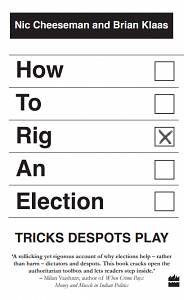In their book on election rigging, Nic Cheeseman and Brian Klaas write fake news factories were the unwitting accomplices of the most high-profile election interference in modern history. Here’s an excerpt:
In February 2016, a young Macedonian teenager posted a false story on his website. Its premise was salacious, its ‘facts’ completely wrong. The story claimed that Donald Trump had accosted someone in the audience at a campaign rally and slapped him. This was not true. But the story took off on social media, and the young teenager made $150 in ad revenues from all the clicks he was generating. In that instant, he decided to quit high school and become a full-time producer and distributor of fake news on America’s elections. Soon, he was raking in large sums of money by generating made-up viral stories.
By October, Veles was home to more than 100 pro-Trump websites. They ran stories such as ‘Pope Francis forbids Catholics from voting for Hillary’ and ‘Proof surfaces that Obama was born in Kenya – Trump was right all along!’ One seventeen year-old involved in the fake news factories of Veles told BuzzFeed News that he did not care about Trump, Clinton or politics in general. Instead, he wanted to buy music equipment. Duping voters in America made that possible: ‘I started the site for an easy way to make money. In Macedonia the economy is very weak and teenagers are not allowed to work, so we need to find creative ways to make some money. I’m a musician but I can’t afford music gear. Here in Macedonia the revenue from a small site is enough to afford many things.’ It is impossible to say precisely how many people read the fake stories that may have been penned by a Macedonian teen in order to finance his desire for musical instruments, but the number is said to be enormous – as high as 126 million on Facebook alone.
Of course, not all the fabricated stories were being produced by youths in Macedonia. Some were written by men in their twenties in Romania. Others by young students in Georgia (the country, not the US state) like Beqa Latsabidze. One of his articles, claiming that Mexico would close its border to Americans if Trump won the election, went viral and earned him some much-needed money to help fund his studies. And, of course, not all the fake stories were coming from outside the United States. One American media company called Disinfomedia, for example, registered domain names like washingtonpost.com.co and usatoday.com.co, in order to try to masquerade as the legitimate news outlets. They published debunked stories too, although some of these American efforts were ideologically rather than financially driven. But wherever the stories came from, the conveyor belt of disinformation likely had a significant impact on voter perceptions of the election campaign and the candidates contesting it.
Sixty-two per cent of American adults reported getting at least some of their news from social media in 2016.That is not necessarily worrying. After all, new media replace old media in cycles, in the same way that mass printing in the nineteenth century drove citizens towards newspapers, and would later face new competition from radio and then television and now the internet. But social media present a new and much more uncontrollable challenge. In 2016, the most viral fake stories were shared more times than the most viral real stories. Furthermore, the sheer scale of the spread of misinformation is astonishing. One 2017 study examined 115 fabricated stories that were pro-Trump and 41 fabricated stories that were pro-Clinton. They found that those 156 stories were shared on Facebook a combined total of 37.6 million times. Each of those shares would be visible to the user’s network of Facebook friends, greatly amplifying its potential reach. A thorough BuzzFeed analysis of social media during the campaign found that several fake news stories eclipsed the social media impact of many genuine news scoops, such as when the New York Times revealed that Donald Trump had actually declared the loss of nearly $1 billion in an unreleased tax return.
All this raises the question of whether the fake ads benefited one side or the other, or cancelled themselves out. Of the twenty most shared fake news articles during the final stages of the residential campaign, seventeen were explicitly pro-Trump or anti-Clinton. As multiple investigations after the election documented, pro-Trump messages were most effective – partly because of the demographics of Trump voters and partly because they had help from Russia to spread the news (of which more shortly). Topping the list of pro-Trump fake news was an absurd story claiming that Pope Francis had endorsed him, followed closely by another fabricated tale suggesting that Hillary Clinton sold weapons to ISIS. Both stories had nearly a million engagements on Facebook, and both were completely made up. Of course, many people would have known that these articles were not to be trusted, but some did not, and many equally false stories were more believable in tone.
Despite appearances, the viral nature of these fake stories was not really organic. Instead, the incentives of impoverished teenagers in Macedonia aligned with the geopolitical machinations of the Kremlin. Fake news factories were the unwitting accomplices of the most high-profile digital election interference campaign by a major state power in modern history. If the analysis of the United States intelligence community is correct, Vladimir Putin sought to influence the election to help elect Donald Trump. This verdict was reached despite Trump’s nonsensical reaction that it ‘could have been anybody’, even, as he suggested, an obese man lying in bed in New Jersey. In the midst of the campaign, inadvertent digital bedfellows ended up forming a potent team against Hillary Clinton.
Whilst some of the false stories are crude, the way in which they are shared is not. Computer algorithms can be used to identify which messages would be most powerful to which users. If you search the internet daily for a job, you are more likely to get economic messages. If your profiles indicate a greater cultural malaise, you might get messages about immigration or ISIS. What you clicked on in the past dictates how digital manipulators may try to influence you in the future.
 This excerpt was taken with permission from the book ‘How to Rig An Election: Tricks Despots Play’ by Nic Cheeseman and Brian Klaas. It was published by Harper Collins India in 2018.
This excerpt was taken with permission from the book ‘How to Rig An Election: Tricks Despots Play’ by Nic Cheeseman and Brian Klaas. It was published by Harper Collins India in 2018.



